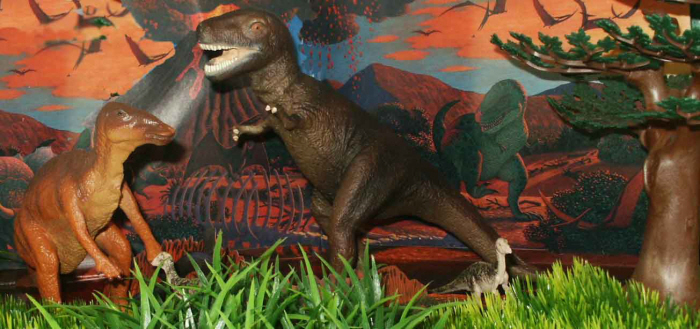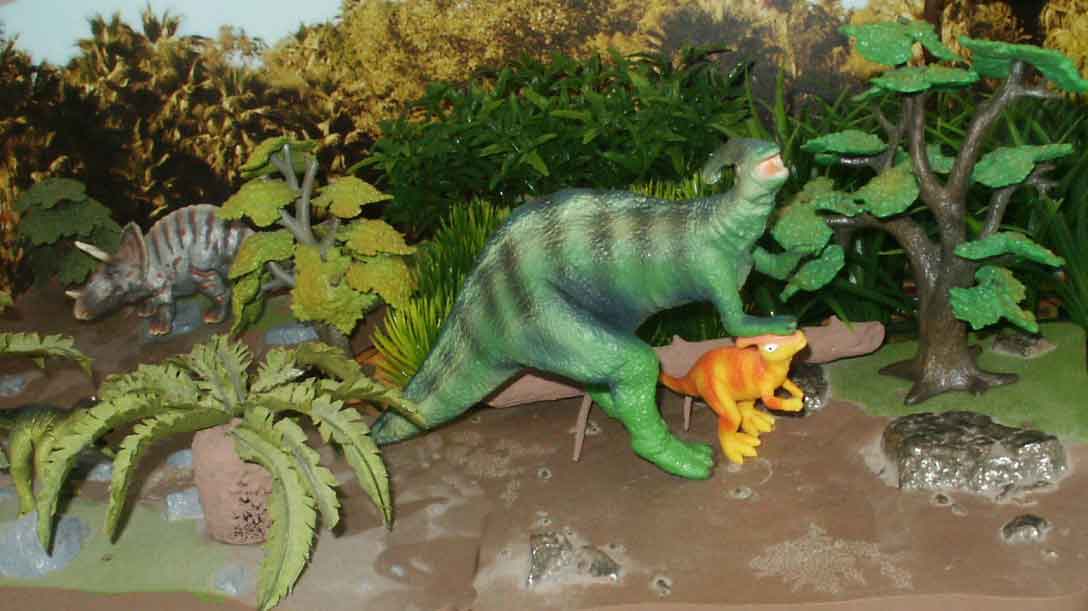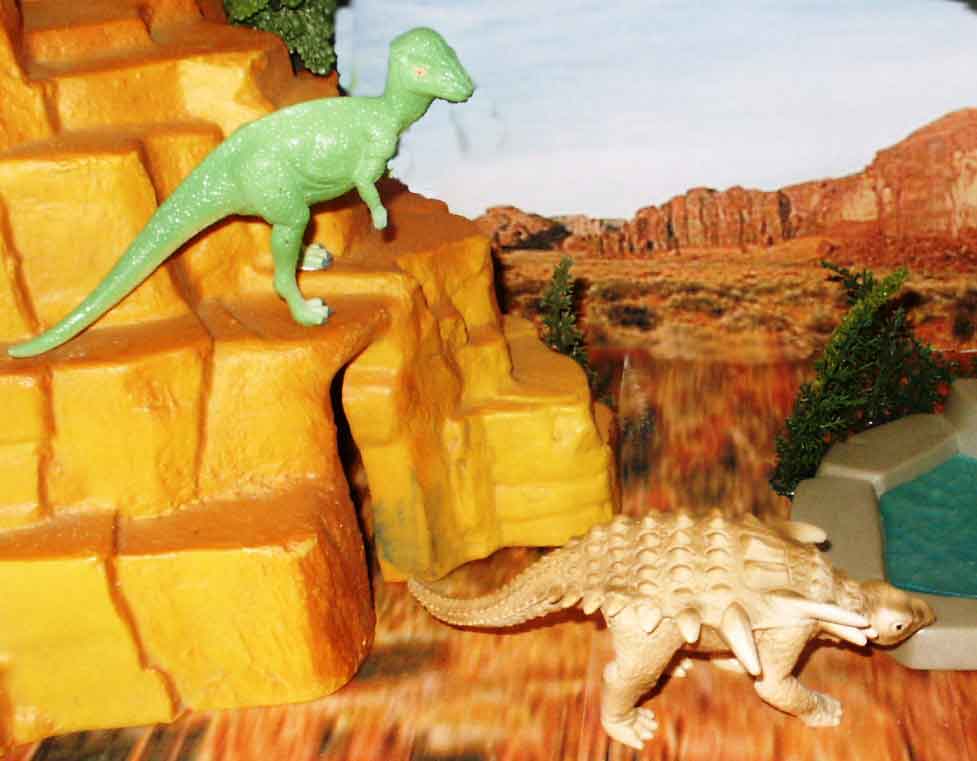
Late Cretaceous
Hell Creek Page 4
From The Dinosaur Collector
Hell Creek formation sites have yielded exciting discoveries, and among recently discovered locations perhaps the Sandy site in South Dakota is one of the most unusual and prolific. More than 3,500 specimens have been unearthed from the Sandy site in South Dakota a pile of loose sand at the top of a hill. Among the more interesting finds is the first North American associated skeleton of a pachycephalosaur, several oviraptors At the end of the period a massive meteor or comet stuck the Yucatan. No dinosaurs have been found after that event. ? It marks the end of the age of the dinosaurs. ???Updated 12/10/06
Master pages Late Cretaceous Diorama pages
Use the links below to see collector pages outside the Hell Creek series. Move your mouse over the picture to find hot spots for more info. Use the arrows at the bottom to cycle through the Hell Creek Diorama.
Edmontosaurus was flat headed with a broad spoon-like beak and pouches around the
nostrils (possibly inflatable) that allowed it to make a loud bellowing call. It was one of the largest
duckbills at 3 tonnes, and one of the last dinosaurs. It is now believed to have had a frill along its back.
The original Schleich Replicasaurus Tyrannosaurus and Edmontosaurus both discontinued. Toyway Leaellynasaura.
Triceratops ( Three Horned Face) belongs to long frilled branch of the horned dinosaurs chasmosaurines although it has a short frill and is larger. No bone beds indicating large herds have been found unlike its earlier relatives. In most cerotopsians the distinctive horns and frills develop as the animals mature. Triceratops develops horns early. Struthiomimus had drooping arms with very long fingers used to scoop up eggs. It had powerful curved claws on fingers and lived on river banks, forests, sandy plains and humid lowlands. It had a long toothless jaw similar to modern birds, and may have had a horny beak and perhaps also ate plants. It was able to run at up to 40 km/h (25 mph). Euornithopods were small (up to 4 m), slim and speedy - the equivalent of dinosaur gazelles. Probably with 5 fingered hands and 4 toed feet, they had short arms but long, agile legs, with shins far longer than the thighs, as in many sprinting animals. They were among the fastest dinosaurs. They cropped vegetation with their beaks (some also had small teeth in the front of the jaw) and chewed with the ridged, high-crowned cheek teeth. Their jaws were better built to crop and chew than those of the early ornithopods. As the teeth ground against each other on top and bottom jaws they were sharpened, and as they wore away, were replaced by new teeth. Thescelosaurus fill a niche found throughout the mesozoic rare at Hell Creek but more common in stressed environments where the larger dinosaurs are dominate.
Schleich Replicasaurs upgraded the original Triceratops (front) the original in the back. Marx Struthiomimus custom painted by Fred Hinojosa Hypsilophodon is a Retro Classic.
Torosaurus (pierced or perforated lizard) the largest of the long frilled ceratopsids, Torosaurus had a skull more than 2.5 m (8 ft) long - one of the largest of any land animal. It had 2 large eye horns and a small nose horn. A partial skeleton with the forelegs articulated seemed to indicate that the legs were not attached directly under the body. whereas trackway evidence suggests the opposite. Nanotyrannus a small version of Tyrannosaurus was originally described as a separate genus was believed by many to be a juvenile T. rex. Assuming it to be valid species it would have been small about 16 feet hunter. Dromaeosaurus is known from an incomplete skull, teeth and fragmentary skull and skeletal remains. It was a small raptor like dinosaur.
 Schleich Torosaurus and junior Tyrannosaurus. Bin raptors.
Schleich Torosaurus and junior Tyrannosaurus. Bin raptors.
Tyrannosaurus predator or scavenger. The arms are too small to be a help in hunting but birds make good predators with out them. The don't seem to have been very fast but their prey Edmontosaurus and Triceratops don't seem to be made for speed. The small pachycephalosaur Stygimoloch had prominent horns on its head, used mainly for show. It lived in woodlands
and was named after the River Styx of Greek mythology, as a play on words from its occurrence in the Hell
Creek Formation. Ornithomimus had thinner arms than Struthiomimus and lived in gloomy swamps and
forests. It may have been able to run as fast as 50 mph. The 2006 ?Tyrannosaurus from Schleich?, the discontinued Edmontosaurus. Oriental Trading Company Ornithomimus and Wai Fong Stygimolch.UKRD 1991 Edmontosaurus.
The 2006 ?Tyrannosaurus from Schleich?, the discontinued Edmontosaurus. Oriental Trading Company Ornithomimus and Wai Fong Stygimolch.UKRD 1991 Edmontosaurus.
Parasaurolophus had a crest like swimmer's snorkel, with a curved hollow horn up to 1.8
m (6 ft) long with complex air passages, including breathing passages that ran from nostril up one side of
crest and down the other side to the mouth. Possibly this was used to make loud bellowing noises, or
perhaps to enhance its sense of smell. It may have had frill from horn to back. Its muzzle was relatively
short.
 Schleich Replicasaurus Parasaurolophus and Triceratops from the Junior set. The Toysmith baby Parasaurolophus.
Schleich Replicasaurus Parasaurolophus and Triceratops from the Junior set. The Toysmith baby Parasaurolophus.
The pachycephalosaur Stegoceras is rare - it probably lived in upland areas where few fossils have
been preserved. It may have lived as mountain sheep do today. Its bony skull was 5 times thicker than a
human’s, and had a smooth, domed roof and frill of bony bumps around the back, but none on the sides. It
had a short deep face, and most of its teeth were sharp. Edmontonia was one of the last and largest nodosaurids. The two main species are characterized by
quite different shaped skulls - E. longiceps’ skull is much longer and narrower than that of E. rugosidens.
 The
Jasman Diorma set Pachycephalosaurus Schleich Edmontonia. The mountains are from the Marx playset. Plants custom made by Fred Hinojosa.
The
Jasman Diorma set Pachycephalosaurus Schleich Edmontonia. The mountains are from the Marx playset. Plants custom made by Fred Hinojosa.
Go to the next Hell Creek page with the arrows
| Previous; Page 3 | Next; Page 5 |
To return you can use the back option
Return to Mesozoic Menu for more diorama